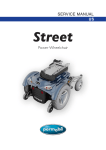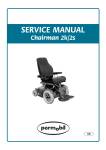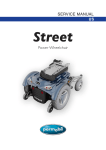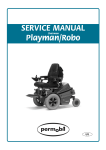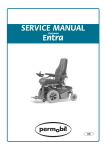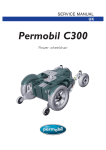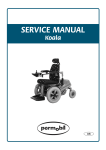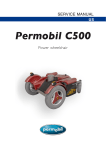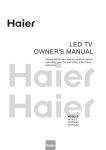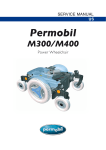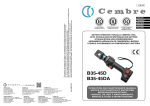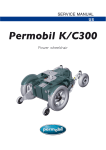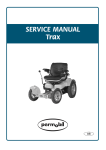Download SERVICE MANUAL Electric wheelchair
Transcript
SERVICE MANUAL US Street Electric wheelchair How to contact Permobil Permobil Inc. USA 6961 Eastgate Blvd. Lebanon, TN 37090 USA Phone: 800-736-0925 Fax: 800-231-3256 Email: [email protected] Head Office of the Permobil group Permobil AB Box 120, 861 23 Timrå, Sweden Tel: +46 60 59 59 00. Fax: +46 60 57 52 50 E-mail: [email protected] Produced and published by Permobil AB, Sweden Edition no.4, 2009-06 Article no.: 205201-US-0 Contents Contents Introduction ....................................................................................................... Technical support........................................................................................... Spare parts .................................................................................................... Warranties...................................................................................................... Maintenance .................................................................................................. 5 5 5 5 5 Identification plates .......................................................................................... Chassi ........................................................................................................... Pilot+ controller.............................................................................................. Control panel ................................................................................................. 6 6 6 6 Covers................................................................................................................ 7 Batteries............................................................................................................. 8 Rear wheels..................................................................................................... 10 Front wheels .................................................................................................... 11 Support wheels ............................................................................................... 12 Shock absorbers............................................................................................. 13 Tie rods ............................................................................................................ 16 Slewing brackets ............................................................................................ 17 Wheel forks ..................................................................................................... 18 Wheel lock release cable ............................................................................... 20 Wheel lock release sensor............................................................................. 22 Magnetic wheel lock ....................................................................................... 23 Drive motor...................................................................................................... 26 Seat elevator ................................................................................................... 28 Manual raising of seat elevator ................................................................... 28 Removal of seat........................................................................................... 28 Removal of seat elevator/Seat column ....................................................... 30 Fixed seat post ........................................................................................... 31 Control panel................................................................................................... 32 Seat control panel ......................................................................................... 32 Pilot+ controller .............................................................................................. 33 SLS drive stage............................................................................................... 34 Circuit breaker and fuses .............................................................................. 35 Circuit breaker ............................................................................................. 35 Charge fuse ................................................................................................. 36 Fuse for seat/lighting ................................................................................... 36 SLS-fuse ...................................................................................................... 37 Lights (Accessorie) .......................................................................................... 38 Trouble shooting............................................................................................. 40 Cabling overview ............................................................................................ 44 Distribution chart ........................................................................................... 46 Index................................................................................................................. 49 4 Introduction Introduction The Service Manual is intended for technical personnel who maintain and repair electric wheelchairs. It is important that anyone who performs maintenance and repairs described in this manual reads and understands the content of this manual so that the work is performed professionally. Always state the chassis number when contacting Permobil to ensure that the correct information is provided. Technical Support In the event of technical problems, you should contact your dealer, or Permobil Inc. USA at 800-736-0925. Spare parts Spare parts must be ordered through your dealer. Warranties Contact your dealer or Permobil Inc. USA for information about the warranties for this chair. Maintenance See the information in the Owner’s Manual. 5 Identification plates Identification plates Chassis Fig. 1. Chassis identification number. Pilot+ controller Fig. 2. Pilot+ controller identification number. Control panel Fig. 3. Control panel identification number. 6 Covers Covers Removal of front cover The cover is attached with a guide pin at each side and hook and loop fastener at the front edge; see figure 4. 1. Run/fold out the leg rests, and if possible, raise the seat elevator. 2. Turn off the main power switch on the control panel. 3. Press the cover’s sides inwards at the shock absorbers’ rear brackets while pulling the cover forward. 4. With the wheel lock release lever at a middle position, detach the cover at the lower edge by pulling it straight forward. Fitting Fitting is the reverse procedure. Removal of rear cover Fig. 4. Front cover attachment points. The rear cover is attached with two guide pins at the back edge and with hook and loop fastener on the inside; see figure 5 1. Chair with seat elevator: Raise the seat to its highest position; turn off the main power switch on the control panel. If the seat elevator cannot be raised because of a fault other than to the seat elevator, it can be raised manually; see page 28. Chair with fixed seat post: Raise the seat to its highest position, see page 31. Chair without seat elevator / fixed seat post: If the chair is not equipped with a seat elevator, remove the seat; see page 28. 2. Pull the cover’s rear edge straight back so that the guide pins disengage; then lift up so that the hook and loop fastener on the inside of the cover releases. NOTE If the chair is equipped with lighting, disconnect the rear-light cabling at the connector fitted on the cabling. Fitting Fitting is the reverse procedure. Fig. 5. Rear cover attachment points. 7 Batteries Batteries Off NOTE On Use protective goggles when working with batteries. Removal of rear battery 1. Place the wheelchair on a level surface. 2. Put the circuit breaker in the “OFF” position. It is accessed through a hole in the chassis cover; see figure 6. Fig. 6. Circuit breaker/Battery isolator. 3. Loosen the rear chassis cover by pulling the cover’s rear edge straight back so that the guide pins disengage. Open the battery cover by turning the knob 1/4 turn counterclockwise and folding down the cover; see figure 7. 4. Pull the battery straight out using the battery belt; see figure 8. Fig. 7. Battery cover locking knob. 5. Disconnect the battery connectors. See the decal on the inside of the battery cover. 6. Lift out the battery. Fitting 1. Lift the battery into place. Leave the belt on the battery to facilitate removal. 2. Connect the battery connectors. See the decal on the inside of the battery cover. 3. Slide the battery into the chassis, checking that the cabling runs free. 4. Close the battery cover and lock with the knob; see figure 7. 5. Fit the rear chassis cover by pushing the cover’s rear edge straight forward so that the cover engages the guide pins. 6. Put the circuit breaker in the “ON” position. It is accessed through a hole in the chassis cover; see figure 6. Fig. 8. Rear battery connection. 8 Batteries Removal of front battery 1. Place the wheelchair on a level surface. 2. Put the circuit breaker in the “OFF” position. It is accessed through a hole in the chassis cover; see figure 6. 3. Remove the front chassis cover; see page 7. 4. Disconnect the battery connectors. See the decal on the inside of the chassis cover. Fig. 9. Front battery connection. 5. Lift out the battery. With a screwdriver through the hole in the front edge of the chassis to facilitate removal, the battery can be lifted; see figure 10. Fig. 10. With a screwdriver through the hole in the front edge of the chassis to facilitate removal, the battery can be lifted. Fitting 1. Lift the battery into place. Put the battery belt on the battery to facilitate removal. 2. Connect the battery connectors. See the decal on the inside of the chassis cover. 3. Fit the front chassis cover; see page 7. 4. Put the circuit breaker in the “ON” position. It is accessed through a hole in the chassis cover; see figure 6. Fig. 11. Front battery removed. 9 Rear wheels Rear wheels Removal 1. Turn off the main power switch on the control panel. 2. Lift the wheelchair chassis and support it on blocks so that the wheel is off the ground. 3. Remove the hubcap (1), bolt (2) and the three washers (3 and 4); see figure 13. 4. Pull the wheel off the shaft. Use puller 304103-99-0 if the wheel is tight; see figure 12. Fitting 1. Check that the wheel shaft and rim are undamaged. Clean as necessary to remove dirt and rust. Replace damaged parts. Fig. 12. Puller 304103-99-0. 2. Check that the key is firmly attached and undamaged; fit a new key if necessary. 3. Lubricate the shaft with a thin layer of copper paste (Würth 0893800x, Art. no.: 1820540). WARNING Do not use any type of lubrication in the threaded hole in the axle or on the bolt. 4. Fit the wheel onto the axle. The use of hand force only is preferred, but, if need be, carefully use a rubber mallet, whose head diameter is no less than 1.5 inches (38 mm), to ensure that the rim is fully seated upon the motor. NOTE Hitting too hard with a rubber mallet could cause damage to the gear. 1 2 5. Mount the three washers (3) and 4) onto the bolt (2) and secure the wheel. Use a torque wrench to tighten the bolt to 24 ft-Ibs (33Nm). Install the hub cap (1). See Fig. 13. Pos. 6 WARNING WARNING Do not use any other type of thread lock. 10 Description 1 Hubcap 2 Bolt, ISO 4762 M8x25 10.9 Fe/Zn 5 C2 / Locking coat DIN 267-28 3 Shim washer DIN 988 8 A2 (DB 8x14x0.5 Stainless) 4 Washer, 8 HB 305 Fe/Zn 5 C2 (TBRSB 8,4x26x5) 5 Rear wheel 6 Key DIN 6885A 6x6x22 NOTE Other types of bolts or washers are not to be used. 5 NOTE The bolt must be used once only. Removed bolt is not allowed to be refitted. 4 Fig. 13. Fitting of rim. The washer (4) should be placed with the most flat side inwards. 3 Front wheels Front wheels Removal 1. Turn off the main power switch on the control panel. 2. Lift the wheelchair chassis and support it on blocks so that the wheel is off the ground. 3. Remove the hubcap (1), bolt (2) and washer (3); see figure 15. Fitting 1. Check that the wheel shaft and rim are undamaged. Clean as necessary to remove dirt and rust. Replace damaged parts. Fig. 14. Front wheel 2. Slide the wheel onto the shaft using hand force only. Ensure that the wheel bottoms on the shaft. 3. Mount the washer (3) onto the bolt (2) and secure the wheel. Use a torque wrench to tighten the bolt to 17.7 ft-Ibs (24Nm). Install the hub cap (1). See Fig. 15. NOTE The bolt must be used once only. Removed bolt is not allowed to be refitted. WARNING Other types of bolts or washers are not to be used. WARNING 1 Other types of locking coatings or fluids may not be used. 2 3 4 Fig. 15. Fitting of rim. Front wheel: 3.00"-4" Pos. Front wheel: 210x65 Pos. Description Description 1 Hubcap 1 Hubcap 2 Bolt, ISO 4017 M8x25 8.8 Fe/Zn 5 C1 / LOCKING COAT DIN 267-28 2 Bolt, ISO 4017 M8x16 8.8 Fe/Zn 5 C1/ LOCKING COAT DIN 267-28 3 Washer, SS 1466 TBRSB 8.4x26x5 HB305 Fe/Zn 5 C1 3 Washer, 8.5x23x3 4 Front wheel(Right) 3.00"-4" Air 4 Front wheel, 210x65 Air Front wheel, 210x65 Solid Front wheel(Left) 3.00"-4" Air 11 Support wheels & shock absorbers Support wheels Removal 1. Turn off the main power switch on the control panel. 2. Remove the bolt; see figure 16. Fitting Fitting is the reverse procedure. WARNING Removal of the support wheels entails increased risk for tipping. The wheelchair may not be operated if the support wheels are not attached. Fig. 16. The support wheels are fitted with one bolt each. 12 Shock absorbers Shock absorbers Removal, front 1. Turn off the main power switch on the control panel. 2. Support the chair on blocks so that the appropriate wheel is off the ground. 3. Unscrew the two bolts that secure the shock absorber; see figures 17 and 19. Fitting Fitting is the reverse procedure. Adjust the shock absorber spring before fitting, see page 14-15. Fig. 17. Front shock absorber. Removal, back 1. Raise the seat to its highest position. To raise it manually, see page 28, 31. 2. Turn off the main power switch on the control panel. 3. Remove the chassis covers; see page 7. 4. Lift the wheelchair chassis and support it on blocks so that the wheel is off the ground. 5. Unscrew the two bolts that secure the shock absorber; see figures 18 and 19. Fitting Fitting is the reverse procedure. Adjust the shock absorber spring before fitting, see page 14-15. Fig. 18. Rear shock absorber. 4 2 1 4 3 5 Pos. 4 1 Description 1 Shock absorber, DNM DV-6 / 350 LBS / IN 2 Bolt, ISO 4762 M6x40 8.8 Fe/Zn 5 C1 3 Bolt, ISO 4762 M6x50 8.8 Fe/Zn 5 C1 4 Washer, 6 Fe/Zn 5 C1 (SRB 6.4x14x1.5) 5 Nut, DIN 985 M6 fzb 4 2 Fig. 19. Shock absorber attachment to chassis. 13 Shock absorbers Adjustment of the DNM Shock absorber Before a new shock absorber is fitted, its spring force shall be adjusted to the correct value; see figure 20. The spring force can be adjusted for various passenger weights with the adjusting nut. Increase the adjustment distance for harder suspension; reduce the adjustment distance for softer suspension. Stop spring Adjustment nut Setting Adjustment of DNM shock absorber springs Passenger weights NOTE Make sure the stop spring is in the right position. Make sure the same model of shock absorber is fitted on both sides of the chassis. Setting, Front 0 - 155 Ib. 0 inch 155 - 220 Ib. 0 - 1/8 inch 0 inch 220 - 264 Ib. 1/8 - 3/16 inch 0 inch Fig. 20. Adjustment of the DNM shock absorber springs. 14 Setting, Rear 0 inch Shock absorbers Adjustment of the KS230 Shock absorber Before a new shock absorber is fitted, its spring force shall be adjusted to the correct value; see figure 21. The spring force can be adjusted for various passenger weights with the adjusting nut. Increase the adjustment distance for harder suspension; reduce the adjustment distance for softer suspension. Adjustment nut Setting Adjustment of KS230 shock absorber springs Passenger weights NOTE Make sure the same model of shock absorber is fitted on both sides of the chassis. Setting, Front 0 - 155 Ib 1 3/16 inch 1 3/16 inch 155 - 220 Ib. 1 3/16 - 1 19/64 inch 1 3/16 inch 220 - 264 Ib. 1 19/64 - 1 3/8 inch 1 3/16 inch Fig. 21. Adjustment of the KS230 shock absorber springs. 15 Setting, Rear Tie rods Tie rods Removal 1. Raise the seat to its highest position. To raise it manually, see page 28, 31. 2. Turn off the main power switch on the control panel. 3. Remove the rear chassis cover; see page 7. Fig. 22. Four tie rods are mounted on the wheelchair's rear suspension. 4. Remove the appropriate tie rod. The tie rods are attached with two bolts each; see figures 23 and 24. Fig. 23. Upper tie rod attachment between the chassis and slewing bracket attachment points. Fitting Fitting is the reverse procedure. Pos. Description 1 Tie rod 2 Washer, ISO 7089 6 200 HV Fe/Zn 5 C1 (6,4x12x1,6) 3 Bolt, ISO 4762 M6x22 8.8 Fe/Zn 5 C1 4 Nut, DIN 985 M6 fzb Fig. 24. Lower tie rod attachment between the chassis and slewing bracket attachment points. 16 Slewing brackets Slewing brackets Removal 1. Raise the seat to its highest position. To raise it manually, see page 28, 31. 2. Turn off the main power switch on the control panel. 3. Put the circuit breaker in the “OFF” position; see page 35. 4. Remove the bolt that secures the slewing bracket; see figures 25 and 26. Front slewing bracket 5. Remove the front shock absorber bracket; see page 13. Fig. 25. Front and rear slewing bracket attachment. For removal of wheel fork, front wheels and friction brake, see the respective chapters. Rear slewing bracket 6. Remove the lower shock absorber bracket; see page 13. 7. Remove the tie rods; see page 16. For removal of drive wheels, drive motor and support wheels, see the respective chapters. Pos. Fitting 1 Bolt, ISO 10642 M10x25 10.9 Fe/Zn 8 C1 / LOCKING COAT DIN 267-28 2 Washer, 3 Bushing, 35/39/48X13 PDE-F Fitting is the reverse procedure. Use a torque wrench to tighten the bolt to 48 ft-Ibs (65Nm). Description 3 3 2 1 Fig. 26. Removal/fitting of slewing brackets. 17 Wheel forks Wheel forks (Item: 1820316, 1820315) Removal 1. Turn off the main power switch on the control panel. 2. Lift the wheelchair chassis and support it on blocks so that the appropriate wheel is off the ground. 5 3. Remove the front wheel; see page 11. 1 4. Remove the wheel fork. It is attached with a bolt from beneath; see figure 27. Fitting 2 3 4 Fitting is the reverse procedure. Use a torque wrench to tighten the bolt to 55 ft-Ibs (75 Nm). Fig. 27. Wheel fork with friction brake. Pos. Description 1 Bearing, 6002-2RS1 (15x32x9) 2 Circlip, DIN 472 Ø32 3 Spacer 4 Bolt 5 Friction brake Friction brake A friction brake unit is mounted on the slewing bracket. The brake’s bearing pressure can be adjusted using the adjusting screw; see figure 28. Fig. 28. Adjusting the friction brake’s bearing pressure. 18 Wheel forks Wheel forks (Item: 1820302, 1820281) 1 Removal 2 1. Turn off the main power switch on the control panel. 3 2. Lift the wheelchair chassis and support it on blocks so that the appropriate wheel is off the ground. 4 3. Remove the plastic plug from the top of the slewing bracket; see figure 29.1. 4. Remove the wheel fork. It is attached with a bolt from above; see figure 29.2. 5 6 Fitting Fitting is the reverse procedure. Assemble the o-ring on the fricion plate, see figure 30. NOTE The friction brake is lubricated with O-ring grease, Item: 1820405. WARNING Fig. 29. Wheel fork with friction brake. Lubricant other than that specified may not be used. Use a torque wrench to tighten the bolt to 24 ft-Ibs (33Nm). Pos. Description 1 Plastic plug, SFL 35 2 Bolt, ISO 10642 M8x16 10.9 Fe/Zn 5 C1 3 O-ringØ24,2x3 EPDM 4 Friction plate 5 Bearing, 6002-2RS1 (15x32x9) 6 Circlip, DIN 472 Ø32 Grease, Momentum, PRO AA 2/0,025 Fig. 30. Fitt the o-ring on the friction plate. 19 Wheel lock release cable Wheel lock release cable Removal 1. Raise the seat to its highest position. To raise it manually, see page 28, 31. 2. Turn off the main power switch on the control panel. 3. Remove the chassis covers; see page 7. 4. Remove the wheel lock release mechanism. It is attached with two screws; see figure 31. Fig. 31. The wheel lock release mechanism is attached with two screws. 5. Remove the lock nut (32.1). 6. Screw in the adjusting screw (32.2) fully. 1 2 Fig. 32. Adjustment of wheel lock release cable. Lock nut (1) Adjusting screw (2). 7. Remove the cable at the magnetic wheel lock by pulling the cable casing forward and passing the cable through the slot in the cable holder. Detach the wheel lock release cable from the magnetic wheel lock. 8. Remove the cable from the release lever. Fig. 33. Wheel lock release cable attachment at the magnetic wheel lock. 20 Wheel lock release cable Fitting 1. Fit the cable at the magnetic wheel lock first, then at the release lever. 2. Adjust the cable sleeve length with the adjusting screw (32.2) so that the cable is sufficiently tensioned so that the wheel lock release sensor (figure 34) is actuated just before the cable pulls the release. 3. Ensure that the wheel cannot be turned before the wheel lock release sensor has been actuated. 4. Ensure that the wheel can be turned when the wheel lock release coupling is released with the release lever. Fig. 34. Wheel lock release sensor. 5. Tighten the lock nut (32.1). 6. Refit the wheel lock release mechanism and the chassis covers. Fig. 35. Mechanism for wheel lock release. 21 Wheel lock release sensor Wheel lock release sensor Removal 1. Remove the chassis cover; see page 7. 2. Put the circuit breaker in the “OFF” position; see page 35. 3. Remove the wheel lock release mechanism; see page 20. 4. Remove the wheel lock release sensor, which is attached with two screws. NOTE If the release sensor is replaced, its connection cables must be re-soldered. Fig. 36. Wheel lock release sensor. Fitting Pos. Fitting is the reverse procedure. 22 Description 1 Wheel lock release sensor, VK08N001A 2 Bolt, ISO 4017 M3x20 8.8 Fe/Zn 5 C1 3 Washer, ISO 7089 3 200 HV Fe/Zn 5 C1 (3,2x7x0,5) 4 Nut, DIN 985 M3 6 Fe/Zn 5 C1 Magnetic wheel lock Magnetic wheel lock Removal 1. Raise the seat to its highest position. To raise it manually, see page 28, 31. 2. Turn off the main power switch on the control panel. 3. Put the circuit breaker in the “OFF” position; see page 35. 4. Remove the chassis covers; see page 7. 5. Remove the magnetic wheel lock’s electrical connection; see figure 37. Fig. 37. Magnetic wheel lock electrical connection. 6. Pull the cable casing forward, out through the slot in the cable holder and detach the wheel lock release cable from the magnetic wheel lock; see figure 38. Fig. 38. Remove the wheel lock release cable. 7. Remove the three screws that secure the wheel lock; see figure 39. Note the position of the wheel lock release lever and rubber seal’s placement to facilitate subsequent reassembly. Remove the wheel lock with wheel lock disk and cover. Fig. 39. Remove the magnetic wheel lock. 23 Magnetic wheel lock Fitting 1. Using the adjusting screws, adjust the magnet wheel lock in accordance with the instructions on the back of the magnetic wheel lock; see figure 40. Fig. 40. Wheel lock adjustment is made using the two adjusting screws. Fig. 41. Magnetic wheel lock, wheel lock disk, cover and rubber seal disassembled. 2. Fit the wheel lock disk in the magnetic wheel lock. 3. Fit the cover. Fig. 42. Magnetic wheel lock, wheel lock disk and cover assembled. 24 Magnetic wheel lock 4. Insert a screw to align the parts. Attach the rubber seal with the drainage hole down. Be attentive to the position of the wheel lock release lever; fit the wheel lock so that the wheel lock release lever is aligned with the motor’s cable bracket. Now fit the magnetic wheel lock using the three screws. Fig. 43. Align the parts with one another using one of the attachment screws. Fit the rubber seal. 5. Connect the magnetic wheel lock’s electrical connection; see figure 44. Fig. 44. Magnetic wheel lock electrical connection. 6. Fit the wheel lock release cable; see figure 45. 7. Fit the covers; see page 7. Fig. 45. Fit the wheel lock release cable. 25 Drive motor Drive motor Removal Off 1. Raise the seat to its highest position. To raise it manually, see page 28, 31. On 2. Put the circuit breaker in the “OFF” position; see figure 46. 3. Remove the chassis covers; see page 7. 4. Support the appropriate side of the wheelchair on blocks. 5. Remove the rear wheel on the appropriate side; see page 10. Fig. 46. Circuit breaker/Battery isolator. 6. Remove the electrical connection for the motor and the magnetic wheel lock. Fig. 47. Magnetic wheel lock and drive motor electrical connection. 7. Remove the rubber ring from the cable pass-through hole; see figure 48. 8. Pull the drive motor’s connection cable out through the chassis cable pass-through; see figure 48. Fig. 48. Cable pass-through. 26 Drive motor 9. Pull the cable casing forward, out through the slot in the cable holder and detach the wheel lock release cable from the magnetic wheel lock; see figure 49. Fig. 49. Wheel lock release cable attachment. 10. Remove the three screws that secure the motor. 11. Turn the motor laterally so that the wheel shaft turns freely. Lift out the motor. Fitting Fitting is the reverse procedure. Fig. 50. Drive motor mounting screws. 27 Seat elevator Seat elevator Manual raising of electrical seat elevator If the seat elevator cannot by raised in the normal manner because of discharged batteries or a fault other than to the control unit, the seat elevator can be raised using cabling with article number 311312-00-0. 1. Turn off the main power switch on the control panel. 2. Remove the rear battery; see page 8. 3. Disconnect the seat elevator cabling at the connector fitted on the cabling. It is accessible from the rear through the rear battery box; see figure 51. Fig. 51. Seat elevator cabling. 4. Connect the cabling to the seat elevator and connect the cabling to a battery or other power source at a maximum of 24 VDC. To temporarily raise the seat elevator, it is sufficient with a standard 12V car battery. Removal of seat Chair with seat tilt 1. Put the circuit breaker in the “OFF” position; see figure 53. 2 1 1 2 2. Remove the two screws that hold the tilt mechanism’s upper part at the front edge; see figure 52.1. 3. Remove the two screws that hold the tilt mechanism’s upper part at the rear edge; see figure 52.2. 3 4. Lift off the seat with the tilt mechanism’s upper part and place it on its side beside the chassis. NOTE Because the seat is heavy, it should be lifted by two persons. Be careful with the cabling. 5. Remove the part of the seat tilt mechanism that remains on the seat elevator/seat column. It is attached with four screws; see figure 52.3. Fig. 52. Seat elevator and seat tilt mechanism. 28 Seat elevator Chair without seat tilt 1. Put the circuit breaker in the “OFF” position; see figure 53. Off On Fig. 53. Circuit breaker/Battery isolator. 2. Remove the four screws on the seat frame bottom that secure the seat frame’s lower section; see figure 54.1. 3. Lift off the seat and place it on its side beside the chassis. NOTE Because the seat is heavy, it should be lifted by two persons. Be careful with the cabling. 4. Remove the part of the seat frame that remains on the seat elevator/seat column. It is attached with four screws; see figure 54.2. Fitting Fitting is the reverse procedure. 1 1 2 Fig. 54. Seat elevator and seat frame. 29 Seat elevator Removal of seat elevator/Seat column/ Fixed seat post 1. Remove the chassis covers; see page 7. 2. Remove the batteries; see page 8. 3. Remove the seat elevator’s upper bracket. It is attached with two screws; see figure 55. 4. Remove the cabling from the SLS circuit board. See page 34 for complete information on removing the SLS circuit board. Fig. 55. Seat elevator’s upper attachment screws. 5. Remove the seat elevator’s four lower attachment screws on the bottom of the chassis; see figure 56. 6. By angling the seat elevator while lifting it, it can be removed without removing the bracket for the SLS drive stage Fitting Fitting is the reverse procedure. Fig. 56. Seat elevator’s lower attachment screws. 30 Fixed seat post Fixed seat post Service position The seat post has a service position that makes it easier to service and repair the wheelchair. 1. Pull out the catch that locks the seat post's fixed height position. With the catch pulled out, turn it through 90°. 2. Raise the seat to the service position. Turn the catch back through 90° so that it can move in and lock the seat in the service position. Ensure that the catch is fully pressed in and locking the seat in the service position. The seat must not be subjected to load and the wheelchair must not be driven with the seat post in the service position. Figure 57. The catch that locks the seat post's height position. If the wheelchair is transported with the seat post in the service position, the position of the seat post must be secured with a screw (M5). See the figure. WARNING Raise and hold the seat firmly when the service position catch is pulled out. Otherwise the seat may fall fast to the normal position, causing personal injury. Ensure that the catch is fully pressed in and locking the seat in the service position. The seat must not be subjected to load and the wheelchair must not be driven with the seat post in the service position. If the wheelchair is transported with the seat post in the service position, the position of the seat post must be secured with a screw (M5). NOTE Figure 58. If the wheelchair is transported with the seat post in the service position, the position of the seat post must be secured with a screw (M5). The seat is heavy. Two people should therefore lift it. Be careful with the cabling. Normal position When the service has been completed, lower the seat to its normal position. 1. Raise the seat carefully and hold it firmly while pulling out the catch. With the catch pulled out, turn it through 90°. 2. Lower the seat to its normal height. Ensure that the head of the securing screw is in contact with the outer tube of the seat post. See the figure. 3. Turn the catch back through 90° so that it can move in and lock the seat in the normal position. WARNING The seat must not be subjected to load and the wheelchair must not be driven with the seat post in the service position. Figure 59. Lower the seat to its normal height. Ensure that the head of the securing screw is in contact with the outer tube of the seat post. Raise and hold the seat firmly when the service position catch is pulled out. Otherwise the seat may fall fast to the normal position, causing personal injury. 31 Control panel & Seat control panel Control panel Removal 1. 2. Switch off the main power switch on the control panel. Put the circuit breaker in the “OFF” position, see page 35. 3. Disconnect the control panel cable by pulling the connector at the rear of the control panel straight backwards. 4. To remove the control panel, remove the screws holding the common bracket for the control panel and Seat control panel, see fig. 60. Remove the control panel bracket by removing the two screws on the rear of the control panel, see fig.61. Fig. 60 The Control panel and Seat control panel bracket. Fitting Fitting is the reverse procedure. Seat control panel Removal 1. 2. Switch off the main power switch on the control panel. Put the circuit breaker in the “OFF” position, see page 35. 3. Remove the cover of the Seat control panel by pulling it straight upwards. If the lid is stuck, you can carefully use a screwdriver to pry between the lid and the lower part of the end of the box, see fig. 62. 4. You can now lift the circuit board and cable out of the box. 5. Disconnect the cable from the circuit board by pulling the connector straight upwards, see fig. 63. 6. To remove the control panel, remove the screws holding the common bracket for the control panel and Seat control panel, see fig. 60. Remove the Seat control panel bracket by removing the two screws on the underside of the box, see fig. 61. Note the position of the bracket for refitting. Fig. 61 The Control panel and Seat control panel fixings. Fitting Fitting is the reverse procedure. Fig. 63. The Seat control panel electrical connector. Fig. 62. Removing the Seat control panel lid. 32 Pilot+ controller Pilot+ controller Removal 1. Raise the seat to its highest position. To raise it manually, see page 28, 31. A B 2. Put the circuit breaker in the “OFF” position; see page 35. C 3. Remove the rear chassis cover; see page 7. D 4. Disconnect the electrical connections to the pilot+ controller, being attentive to their placement: see figure 64. E NOTE A: SLS circuit board B: Left drive motor C: Power feed D: Right drive motor E: Control panel Fig. 64. Pilot+ controller cable connections. The Pilot+ controller connectors A and E have the same function. Cabling from SLS circuit board and control panel can therefore be switched if desired. 5. Remove the Pilot+ controller by removing its two attachment screws; see figure 65. Fitting Fitting is the reverse procedure. Fig. 65. The Pilot+ controller is attached with two screws. Fig. 66. Pilot+ controller 33 SLS Drive stage SLS Drive stage Removal 1. Raise the seat to its highest position. To raise it manually, see page 28,31. 2. Put the circuit breaker in the “OFF” position; see page 35. 3. Remove the rear chassis cover; see page 7. Fig. 67. SLS Drive stage. 4. Lift the SLS Drive stage straight up from its holder; see figure 68. 5. Remove the lid from the drive stage. 6. Clip the cable ties that hold the cables and its electrical connections, being attentive to their placement to facilitate subsequent refitting. Fitting Fitting is the reverse procedure. Fig. 68. SLS Drive stage unattached in its holder. Fig. 69. SLS Drive stage. 34 Circuit breaker and fuses Circuit breaker and fuses Resetting the circuit breaker Off The circuit breaker also serves as a battery isolator but is normally referred to as a circuit breaker. On Circuit breaker replacement is normally not required; it is of the automatic type that can be reset when tripped. It is mounted on the chassis to the right of the seat elevator; see figure 70. NOTE A tripped circuit breaker often entails a major electrical fault. The cause should be carefully investigated before resetting. Circuit breaker replacement 1. Remove the chassis covers; see page 7. 2. Put the circuit breaker in the “OFF” position; see figure 70. 3. Disconnect the minus cable from the front battery. 4. Disconnect the plus cable from the rear battery. Fig. 70. Circuit breaker/Battery isolator. NOTE Bend the battery connection cables off to the side to prevent them from coming in contact with the battery terminals. 5. Remove the circuit breaker from its bracket. The circuit breaker is removed by pressing the plastic clip on one side of the circuit breaker outwards using a screwdriver; see figure 71. NOTE Note the orientation of the circuit breaker with consideration to subsequent mounting. The ON/OFF positions must agree with the decal. 6. Disconnect the cables from the circuit breaker by removing the screws; see figure 72. 7. Put the new circuit breaker in the “OFF” position. 8. Connect the cables to the new circuit breaker. Fig. 71. Circuit breaker bracket. NOTE Check that the cables are firmly attached. 9. Fit the new circuit breaker to the bracket. NOTE Note the orientation of the circuit breaker. The ON/OFF positions must agree with the decal. 10. Reconnect the battery connection cables to the batteries. 11. Refit the chassis covers; see page 7. 12. Put the circuit breaker in the “ON” position; see figure 70. Fig. 72. Circuit breaker cable connection. 35 Fuses Charge fuse replacement The charge fuse is mounted at the front of the chassis, under the wheel lock release lever; see figure 73. Turn off the main power switch and the charger, if in use, before replacing the charge fuse. NOTE The circuit breaker must be in the “ON” position during charging. Fuse replacement for seat/lighting There are two fuses on the SLS Drive stage, F1 (24V unswitched) and F2 (24V switched). These protect two outlets. One output (24V unswitched) supplies power regardless of if the chair is turned on or off. The other output (24V switched) supplies power only when the chair is turned on. The seat and lighting are normally connected to this outlet. Fig. 73. Charge fuse. 1. Raise the seat to its highest position. To raise it manually, see page 28, 31. F1 F2 2. Put the circuit breaker in the “OFF” position; see page 35. 3. Remove the rear chassis cover; see page 7. 4. Lift the SLS Drive stage straight up from its holder; see page 34. 5. Remove the lid from the drive stage. 6. Replace the blown fuses. 7. Refit the lid to the box. 8. Place the SLS Drive stage in its holder. 9. Refit the covers; see page 7. Fig. 74. F1: 24V unswitched 15A. F2: 24V switched 15A Seat/Lighting. 36 Fuses Fuses Replacing the SLS Fuse The SLS fuse is located in its holder on the top of the front battery. 1. Switch off the main power switch on the control panel. 2. Put the circuit breaker in the “OFF” position. It is accessed through a hole in the chassis cover; see page 35. 3. Remove the chassis front cover, see page 7. The SLS-fuse is fitted by the positive battery pole on the front battery, see Fig. 75. Fig. 75. The SLS-fuse is fitted by the positive battery pole on the front battery. 4. Open the cover of the fuse holder by pulling it straight out. 5. Replace the blown fuse. 6. Close the cover of the fuse holder. 7. Refit the chassis front cover, see page 7. 8. Put the circuit breaker in the “ON” position; It is accessed through a hole in the chassis cover; see page 35. Fig. 76. Replacing the SLS-fuse. 37 Lights Lights (accessory) Removing the front lights 1. Switch off the main power switch on the control panel. 2. Remove the front chassis cover. See page 7. 3. Chock up the chair so that the front wheel on the relevant side is freely suspended. 4. Unscrew and remove the screw with which the shock absorber and the light are fitted to the chassis. See the picture. 5. Unscrew and remove the other screw with which the light is fitted. See the picture. Fig. 77. The light is fitted with two screws. The upper screw also holds the shock absorber. 6. Cut off the cable ties that hold the cables. 7. Divide the light's cables at the contact on the cables. This is loose inside the chassis. Installation Install the lights in the reverse order. Replacing a bulb 1. Switch off the main power switch on the control panel. 2. Unscrew and remove the two screws that hold the light's insert. Remove the insert. See the picture. 3. Remove the bulb holder by pulling it straight out. Replace the bulb. 4. Reinstall in the reverse order. Fig. 78. The light's insert and bulb holder.Fig. 78. The light's insert and bulb holder. Fig. 79. The light's insert is fitted with two screws. 38 Lights Lights (accessory) Removing the rear lights 1. Switch off the main power switch on the control panel. 2. Remove the rear chassis cover. See page 7. 3. Divide the light's cables at the contact on the cables. 4. Remove the two screws that hold the light. They are located inside the cover. See the picture. Installation Install the lights in the reverse order. Fig. 80. Rear lights.Fig. 80. Rear lights. Replacing a bulb 1. Switch off the main power switch on the control panel. 2. Remove the rear chassis cover. See page 7. 3. From the inside of the cover, remove the bulb holder by pulling it straight out. Replace the bulb. 4. Reinstall in the reverse order. Fig. 81. The light's insert is fitted with two screws. 39 Trouble Shooting Guide Trouble Shooting Guide The troubleshooting guide below describes a number of events that can arise when you use your wheelchair, as well as providing suggestions for solutions. Note that this guide does not describe all the possible events that can arise, and you should always get in touch with your service contact or Permobil when you are unsure EVENT The wheelchair does not start. POSSIBLE CAUSE SOLUTION Batteries discharged. Charge the batteries. The cable connection to the conttrol panel has become loose. Atttach the cable to the control panel. Main fuse set in ”OFF” position after, for example, changing batteries. Reset the main fuse. See page 35. Main fuse triggered. See page 35. Battery charger connected. Terminate the charging and remove the charging cable from the charging outlet. Wheel lock release activated. Reset the wheel lock release. Wheelchair locked with the security key. Unlock the wheelchair. See Owner´s manual. Applies for electrical controlled seat tilt only. Seat tilt activated more than 30°. Run the seat tilt back. See Owner´s manual. Applies for electrical controlled leg support only. Foot plates run in too close to the front wheels. Run the leg support out. See Owner´s manual. Battery voltage indicator on the control panel blinking once every 2.5 seconds and the wheelchair can not be driven. The control system is in Sleep Mode. Switch the start button on the control panel off and on again. Battery voltage indicator on the control panel rapidly blinking and the wheelchair can not be driven. Fault indicated in the drive electronics. See page 42-43. The wheelchair stops while being driven. The cable connection to the control panel has become loose. Atttach the cable to the control panel. Applies for electrical seat tilt only. Seat tilt activated more than 30°. Run the seat tilt back. See Owner´s manual. Applies for electrical leg support only. Foot plates run in too close to the front wheels. Run the leg support out. See Owner´s manual. The wheelchair can not be driven. 40 Trouble Shooting Guide EVENT The wheelchair can only be driven with reduced speed. Applies for electrical seat lift, seat tilt or back rest only. The seat lift will not raise. Applies for electrical seat tilt alt. back rest only. The seat tilt will not tilt upwards. POSSIBLE CAUSE SOLUTION Seat tilt or seat lift raised to high, alt. backrest activated more than 15°. Lower seat lift or seat tilt, alt. move the back rest forward. See Owner´s manual. Seat tilt activated more than 10° alt. back rest is activated backwards more than 10°. Run the seat tilt alt back rest back. See Owner´s manual. Seat lift raised to high. Lower the seat lift. See Owner´s manual. Seat lift raised more than 2.5 in. from its lowest postition. Lower the seat lift. See Owner´s manual. Main fuse set in ”OFF” position after, for example, changing batteries. Reset the main fuse See page 35. Triggered charging fuse due to fault in, for example, batteries, charger, charging cables, charging outlet. Carefully check possible causes before replacing. See page 36. Applies for electrical seat lift and seat tilt only. The back rest will not tilt backwards. Applies for electrical seat lift and back rest only. The wheelchair will not charge. 41 Trouble Shooting Guide Error signals - Battery voltage indicator Every time the wheelchair is started up, a check is performed on parts of the wheelchair’s electronics. If any faults have arisen in these parts, this is shown on the control panel’s battery voltage indicator by one or more blinking lights. Constant light Everything is in order. How many lights are lit, depends upon how much voltage there is in the batteries. With fully charged batteries, all lights are lit. Slowly blinking red lights The batteries need to be charged immediately. Rapidly blinking, 1 - 10 lights Error signals, an error has arisen and the wheelchair can not be driven. Error signals The number of blinking lights indicate what the problem could be. – Note the number of blinking lights. – Turn off the wheelchair. – Turn the wheelchair back on again. – If the error persists, count the number of blinking lights, check possible causes and solutions in the table on the adjoining page. NOTE Possible error signals on the battery voltage indicator are not displayed while the wheelchair is being driven, they only first appear the next time the wheelchair is restarted. WARNING The remedying of errors that are indicated via the battery voltage indicator must be performed by a person with sufficient expertise to be able to perform such in a professional manner. Always contact an authorized serviceman when in doubt. 42 Trouble Shooting Guide CAUSE High battery voltage Failure in wheel lock circuit Fault in electronics Fault in the control panel SOLUTION Green Check the battery and the connections between the battery and the control unit. 9 Check the connections to the magnetic wheel lock. 10 Green 8 Green 7 Orange Check the contacts to the output stage. If the fault persists, change the output stage. Make sure the joystick isn’t actuated at switch-on, change the control panel. 6 Orange Short circuit right drive motor Open circuit, right drive motor Short circuit left drive motor Open circuit, left drive motor Low battery voltage 5 Orange 4 Orange 3 Red 2 Red 1 Red Check the drive motor connections and cable. Check the connection to the right drive motor. Check the drive motor connections and cable. Check the connection to the right drive motor. Check the condition of the battery. Check the connection between the battery and the control unit. Example: Lights 1-7, 3 red and 4 orange, blinking rapidly upon start-up and the wheelchair can not be driven. Cause: Fault in the control panel. Solution: Make sure the joystick isn’t actuated at switch-on, change the control panel. 43 Cabling overview 1 2 3 A B C D E F 44 4 Cabling overview 5 6 7 8 A B C D E F Cabling overview 45 Distribution chart 1 2 3 A B C D E F 46 4 Distribution chart 5 6 7 8 A B C D E F Distribution chart 47 Notes 48 Index Index B P Batteries .............................................. 8 Pilot+ controller ................................ 33 C R Cabling overview .............................. 44 Rear wheels........................................ 10 Charge fuse........................................ 36 S Circuit breaker .................................. 35 Seat elevator ...................................... 28 Contents .............................................. 4 Seat control panel ............................ 32 Control panel .................................... 32 Shock absorbers .............................. 13 Covers .................................................. 7 Slewing brackets .............................. 17 D SLS drive stage.................................. 34 Distribution chart .............................. 46 SLS fuse ............................................ 37 Drive motor ........................................ 26 Spare parts .......................................... 5 F Support wheels.................................. 12 T Fixed seat post .................................. 31 Front wheels ...................................... 11 Technical support ................................ 5 Fuses .................................................. 35 Tie rod ................................................ 16 I Trouble shooting .............................. 40 Identification plates ............................ 6 W Introduction.......................................... 5 Warranties ............................................ 5 L Wheel forks ........................................ 18 Wheel lock release cable .................. 20 Lights (Accessorie) ............................ 38 Wheel lock release sensor .............. 22 M Magnetic wheel lock.......................... 23 Maintenance ........................................ 5 Manual raising of seat elevator........ 28 49 Article no: 205201-US-0




















































